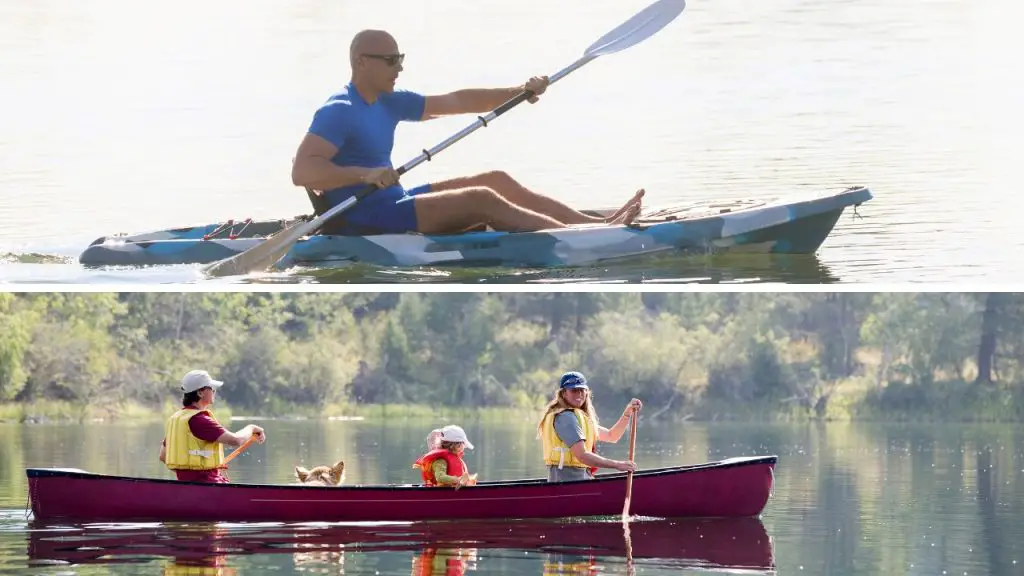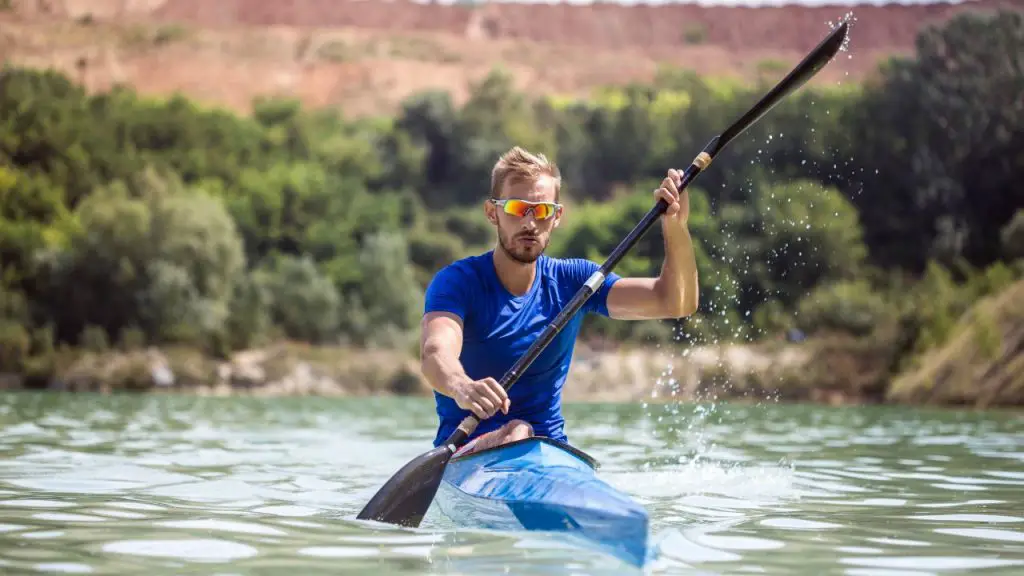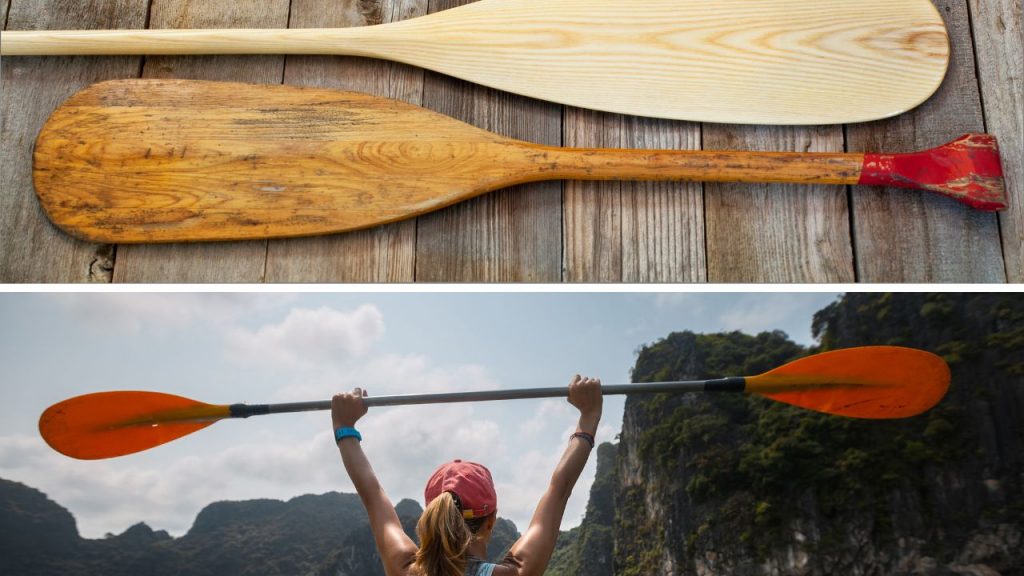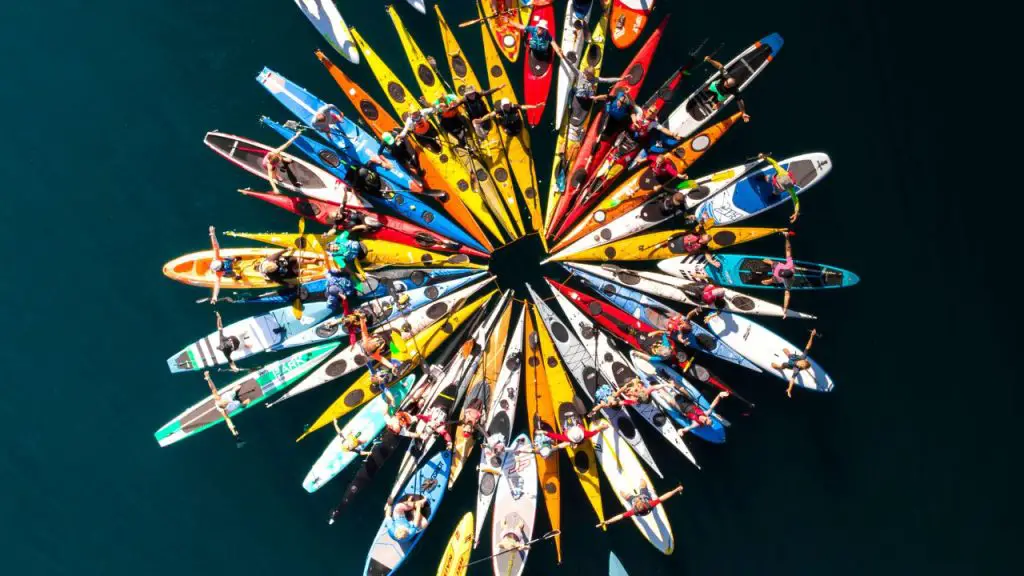Do you know the difference between a kayak vs canoe? If not, don’t worry – many people don’t! In this blog post, we will discuss the key differences between these two types of boats, including what particular purpose they’re made for, their load capacity, and the particular paddle designs needed to use them.
Both kayaks and canoes have their pros and cons, so it is important to understand them before you decide which one to buy for the tasks that you need them to accomplish.
Table of Contents
What Came First: Canoe or Kayak?

According to seminal book on canoes called Canoes of the Grand Ocean by historian Anne Di Piazza, canoes were developed before kayaks, with the famous Pesse Canoe serving as the best evidence.
The historic canoe is believed to have been constructed in the Mesolithic era around 8000 – 7500 B.C. They were versatile watercraft used for transportation, trade, and hunting.
On the other hand, the Eskimos made up of the Inuit, Aleut, and Yup’ik tribes of North America and certain locales in North Eastern Russian territories, are credited as the inventors of the kayak.
John Heath’s Eastern Arctic Kayaks: History, Design, Technique, on the other hand, states that they invented the vessel with the sole purpose of hunting whales, seals, and other sea animals.
The Inuit tribe also introduced the vessel in the waters of Greenland as a contingent of the tribe migrated there between 1200 to 1400 A.D., essentially spreading the idea of the kayak across continents.
Kayak vs Canoe: 5 Key Differences

Kayaks and canoes differ in 5 key areas – their purpose, design, weight and load capacity, seating positions, and the types of paddles used.
If you’re getting into paddling, knowing these differences is important to decide which one will better suit your needs.
Purpose
Perhaps one of the most important differences between the two vessels is their intended use case for the people that invented them.
Canoes were designed to be stable, multi-purpose vessels that could be used for transportation, hunting, and trade.
On the other hand, kayaks were designed with a single purpose in mind – hunting in the frigid waters of the Arctic.
It’s important to note that the kayak was never designed to be weight-bearing as hunters relied on other boats called the umiaqs to drag the carcass of the day’s catch to the shore.
Design

Because canoes are expressly crafted to be used in various use cases, their design is much more versatile.
Canoes are typically much longer than kayaks, with an open top allowing easy loading of supplies and people. They can also be paddled solo or in tandem, depending on the size of the canoe.
On the other hand, kayaks have a closed deck design that makes them more difficult to get in and out of.
While extremely constricting, this design is perfect for its purpose as the closed deck protects kayakers from waves and splashing water, which is key in cold weather conditions.
They are also typically paddled solo, with the paddler sitting lower in the vessel to provide greater stability and control while hunting in treacherous waters. It’s important to note that modern designs have led to tandem kayaks that allow for 2 paddlers.
Its extremely narrow design makes it possible to roll the vessel over without the paddler ever going out of the boat, even if it’s completely flipped due to strong waves or the force of the whales that the paddlers are hunting.
The closed deck also makes it buoyant as water does not enter the hull. The sleek form factor also helps glide the kayak across the water’s surface, keeping it stealthy and nimble when out on the hunt.

Weight and Load Capacity
The weight-bearing capacity of a canoe depends on its design, shape, and material.
The average canoe can carry around 600 – 800 lbs of weight, including the people and supplies inside. Some larger models can accommodate up to 1400 lbs.
On the other hand, Kayaks have a smaller carrying capacity than canoes, averaging between 250 – 350 lbs, just enough for the weight of the paddlers and a few supplies.
Some larger tandem kayaks can support up to 600 pounds, but this is still significantly less than what a canoe can carry.
Seating Positions
The seating positions in a canoe are typically more comfortable, with people sitting on benches that run along the vessel’s sides. This gives paddlers more room to move around and shift their weight to help maneuver the canoe.
Kayaks have a much more cramped design, with the paddler sitting right on the vessel’s floor. This design helps to lower the center of gravity and makes it easier to control in rough waters but can be uncomfortable for long periods of time.
Paddles
The paddles used for kayaks and canoes are also different, each designed for specific use cases. Canoe paddles are typically much longer and have a single blade to propel the vessel through the water.
On the other hand, Kayak paddles are much shorter with a double-bladed design that helps with maneuverability and control in tight spaces.

Kayak Vs Canoe: Which Is Better?
At the end of the day, there is no clear winner between kayaks and canoes. They are both great vessels that have their own unique advantages and disadvantages.
It comes down to what you need the vessel for and your personal preferences.
If you’re looking for a vessel to take on long trips or carry a lot of supplies, then a canoe is probably the better option.
If you’re looking for something that is more maneuverable and easier to control in tight spaces, then a kayak is probably the better option.
Pros and Cons of a Kayak
There are a few pros and cons to kayak that paddlers should be aware of before they venture out onto the water.

Pros of a Kayak
- Can be paddled solo or in tandem.
- Closed deck protects kayakers from waves and splashing water.
- Paddler sits lower in the vessel to provide greater stability and control.
- Extremely narrow design makes it possible to roll the vessel over without the paddler ever going out of the boat.
- Sleek form-factor helps a lot in gliding the kayak across the surface of the water.
- Shorter paddles with a double-bladed design that helps with maneuverability and control in tight spaces.
Cons of a Kayak
- Smaller carrying capacity than canoes.
- More cramped design can be uncomfortable for long periods of time.
- Paddles are asymmetrical, which can be difficult to generate power on one side while still providing some resistance on the other.
Pros and Cons of a Canoe
There are pros and cons to every decision we make in life, and choosing to go on a canoe trip is no different. Here are some things to consider before you decide whether or not a canoe trip is right for you.

Cons of a Canoe
- Can carry around 600 – 800 lbs of weight, including the people and supplies inside, some larger models can accommodate up to 1400 pounds.
- Seating positions are typically more comfortable with people sitting on benches that run along the vessel’s sides.
- Canoe paddles are typically much longer and have a single blade that is used to propel the vessel through the water.
Cons of a Canoe
- Longer and heavier than kayaks, making them more difficult to transport
- Tippier than kayaks due to the higher center of gravity
- Paddles are only single-bladed, making it difficult to generate power on one side. It takes some skill to keep the canoe going straight.
FAQs
Is it easier to kayak or canoe?
Kayaks are easier to get into because they’re lighter and smaller. These factors make them much easier to transport from home to wherever you use them.
What makes a canoe different from a kayak?
Almost all of the differences between kayaks and canoes stem from the difference in their purposes. Canoes were made to be versatile, while kayaks were crafted to be used in specific conditions.
Is a kayak better than a canoe?
In certain conditions, a kayak is better than a canoe. If you’re simply touring, the cons of kayaks essentially vanish.
Its low weight capacity, for example, becomes a non-issue when you’re not carrying supplies. Kayaks are also better at handling waves and white water.
Which is more difficult, kayak or canoe?
Canoes generally require more technical skills to maneuver since they’re bigger and heavier. They’re also more difficult to transport.
Kayaks are much easier to get in and out of the water. They’re also lighter and require less effort to paddle
Final Thoughts
So, what’s the difference between kayaks and canoes? Well, quite a few key differences set these two vessels apart.
Canoes are stable, multi-purpose vessels that can be used for transportation, hunting, and trade, while kayaks have a closed deck design that makes them more maneuverable and easier to control in tight spaces.
No matter your choice, you’re sure to have a great time out on the water! Just be sure to consider your personal preferences before making your decision. Happy paddling!

